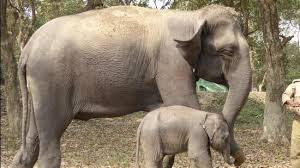Teams fan out to track elephant and calf that trampled 3, including toddler, to death

A wild elephant and her calf killed three people, including a toddler, in Chhattisgarh’s Lailunga forest range. The attack took place early on Tuesday and left local communities in shock. Forest officials have launched a large-scale operation to track the elephants and prevent more casualties.
The Night Attack
The elephant pair entered Gosadih village around 2 a.m. on Tuesday. Villagers, who slept outside to escape the summer heat, woke to chaos when the animals stormed in. A three-year-old boy, Satyam Rawat, was trampled while sleeping outside his home. His family could not save him in time.
After leaving Gosadih, the elephants moved to Mohanpur village, about 5 kilometers away. There, they killed 46-year-old Santara Bai Rathiya and 48-year-old Purushottam Khadia. One victim was crushed while fleeing, and the other died when a mud wall collapsed during the attack. The sudden violence sparked fear and anger among villagers, who demanded stronger preventive measures.
Forest Teams in Action
Forest officials rushed to the scene and quickly formed special tracking teams. These teams are using drones, forest guards, and local trackers to follow the elephants’ movements. “We are monitoring them carefully and trying to guide them back into deep forest,” said a senior officer. Teams have also started round-the-clock patrols in nearby villages.
Officials are warning residents to avoid sleeping outdoors and to stay alert. Loudspeaker announcements and mobile alerts are being used to warn communities when elephants approach.
Relief for Victims’ Families
The Chhattisgarh forest department released immediate compensation of ₹25,000 to each victim’s family. Officials confirmed that a total compensation of ₹6 lakh will follow after necessary paperwork. District leaders visited the area to reassure residents and promise stronger action.
Despite the aid, villagers expressed frustration. Many demanded electric fencing, early-warning sirens, and quick-response teams. “We live in fear every night,” said a Mohanpur resident. “We need long-term solutions, not just temporary relief.”
Rising Human-Elephant Conflict
Northern Chhattisgarh has seen a sharp rise in human-elephant conflicts over the last decade. Districts like Raigarh, Korba, Surguja, and Balrampur report frequent incidents. Over 320 people have died in such attacks in the past five years alone.
Experts blame habitat loss for these conflicts. Deforestation, mining, and farmland expansion have cut elephant corridors. “Elephants enter villages when they cannot find food or water,” explained a wildlife expert. “A female with a calf can become aggressive if she senses danger.”
Safety Tips for Villagers
Authorities are teaching residents how to stay safe. They recommend avoiding outdoor sleeping, keeping flashlights ready, and reporting sightings immediately. Forest officials have also set up temporary shelters in safer zones near vulnerable villages.
Public meetings and leaflets are spreading awareness. “The goal is to save both human lives and elephants,” said a forest officer.
A Need for Long-Term Action
Tracking and relocating the elephants is a short-term fix. Conservationists call for stronger measures, such as restoring elephant corridors and improving forest water sources. Wildlife NGOs are pushing for better coordination between officials and local communities.
“We need to reduce conflicts by protecting elephant habitats,” said a conservationist. “Otherwise, these tragedies will continue.”
Current Situation
Forest teams continue tracking the elephant and calf using drones and night-vision cameras. Officials promised to keep patrols active until the animals move back to safe forest areas.
Tension remains high in the villages. Families mourn the loss of their loved ones, and many fear another attack. “We just want to live without this fear,” said a relative of one victim.






